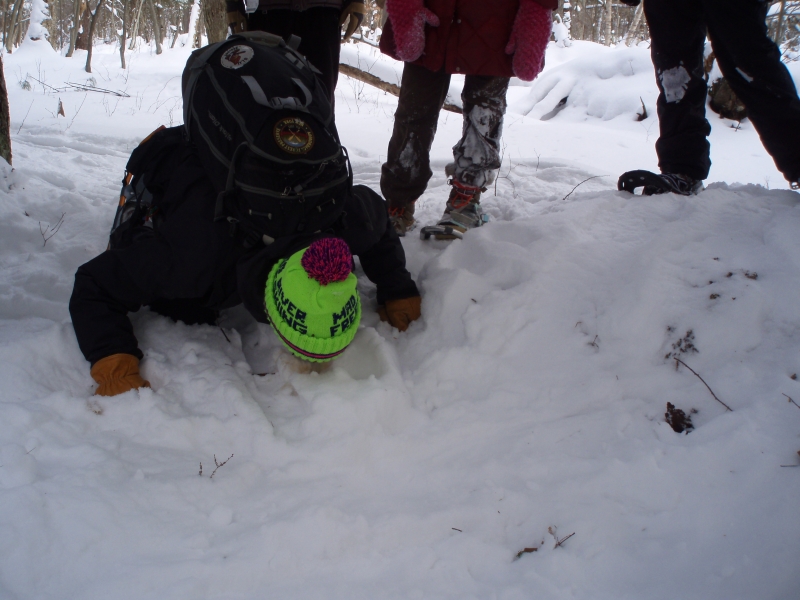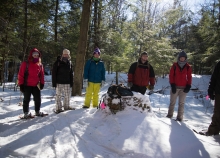
Winter Ecology Week 1: New Sights, New Smells, New Snacks
This winter Nature Up North is featuring a Winter Ecology Series, in which St. Lawrence University students in Dr. Karl McKnight's Winter Ecology course share their observations from a weekly field trip to Glenmeal State Forest in Pierrepont. We hope you enjoy their accounts from days spent in the woods examining the fascinating ways plants and animals endure the North Country winter.
By Catherine Bennet
On the first Thursday of the St Lawrence Spring semester, a good friend of mine asked me how things were going. I thought my response was perfectly reasonable: “Did you know deer urine smells like dill weed?”
Of course, my friend – and the many others I educated that day – was slightly confused, but his interest began growing as I explained that porcupine urine smells like pine needles, and that hemlock tastes like (warning to parents) marijuana.
We are the Spring 2015 St Lawrence University Winter Ecology class. Taught by the resilient Karl McKnight, the nine of us spend from 10:00 to 4:00 on Thursdays tromping through the wilds of Glen Meal State Forest in Pierrepont. Tuesdays are spent inside, discussing related readings such as, “Life in the Cold” by Peter Marchand, “Winter: A spiritual biography of the season” edited by Gary Shmidt and Susan Felch, and “Winter World: The Ingenuity of Animal Survival” by Bernd Heinrich.
~
 That first Thursday, each of us acquired a pair of snowshoes, a device I’d never personally been able to walk in until this semester. Not knowing exactly what the plan was, we followed Karl into the forest. My feelings were mixed – exuberantly excited, thrilled I had had the sense to find warmer mittens, and a little worried that the rest of my clothing wouldn’t stand up to the wind and (slightly) frigid air.
That first Thursday, each of us acquired a pair of snowshoes, a device I’d never personally been able to walk in until this semester. Not knowing exactly what the plan was, we followed Karl into the forest. My feelings were mixed – exuberantly excited, thrilled I had had the sense to find warmer mittens, and a little worried that the rest of my clothing wouldn’t stand up to the wind and (slightly) frigid air.
Almost immediately we encountered a track that I had never seen before - about 6 inches (15 centimeters) wide, a trench had been plowed through the snow. As we surrounded the trail, Karl pointed out telltale signs that it was, in fact, a porcupine’s – the trench (indicating a low-to-the-ground animal) the turned-in paw prints, and the width of 9 – 10 centimeters (3.5 - 4 inches) from outside edge to outside edge.
Travelling that day we eventually stumbled upon mouse, deer, coyote, and squirrel tracks, as well as the recently drilled holes of a pileated woodpecker. We also ran into the aforementioned deer and porcupine urine. Eager for us to broaden our horizons, Karl encouraged us to smell everything, and after some hesitation, we began to follow his lead. While I personally am proud of my new-found ability to identify the origin of a splash of urine, I am also curious as to what draws porcupines to eat so much hemlock, given that its complex flavors fall away to reveal such an upsettingly disgusting aftertaste. Remembering that every track we saw would, at one point, look like every other track, we soldiered on, fulfilling missions as we went.
Mission One: Keep warm. Even I, a native of the north and no stranger to snow, was in for some uncontrollable shivering once we returned to campus. I vowed to sew string onto my mittens for the next experience, because having to hold them or drop them in the snow every time I took notes was a bigger pain than my frozen right toes.
Mission Two: Understand where you are, and be able to identify your relative location in the woods. There’s no good in being out there if you can’t keep yourself safe, right? At various intervals Karl would stop the class and ask us to point to our designated meeting location. Third time around he said, “Well, good job, guys – it’s over there,” and pointed in the opposite direction of every single one of us. You’d think by then we would have constructed a general map in our heads, but with four glacial boulder ridges and snow covering many landmarks, it was easy to be surprised by your own inattentiveness.

Mission Three: Select our study locations. Given that the ten of us make a fair amount of noise (we actually upset a porcupine the second week, but that’s a tale for Justin to tell), it was nice to know that each of us would get to choose, from pre-designated locations, our own ‘study spot.’ These would be our semester-long lookouts, our lunching areas; places to make our own observations and revel in the beauty and wonder of the winter days. As we hiked along and through the four saddles of Glen Meal, we gave each study spot a class name. Porcupine Hotel was christened in honor of the bulging rock formation frequented by many Erethizon dorsatum. The Cave lies between two rock saddles, and is the perfect location for lovers of large trees. Traveler’s Pass was littered with footprints, hoofmarks, and tail drags – a popular highway, if you will. Nine students, nine locations. These will become our ‘homes’ for the rest of the semester; it is in the plans to camp out one night in our respective locations.
Mission Four: Collect data. I would never venture to say we will fully understand the world, but in order to increase our awareness of a winter at Glen Meal, the class installed HOBO pendant loggers and Pro V2 Weatherproof loggers. These devices will record the respective light levels, temperature, and humidity. At the end of the semester, we will have a clearer picture of the weather that occurred when we weren’t around. Every Thursday, we also record the snow density; measuring how deep our handy tennis ball, golf ball, and 200 milligram weight fell into the snow. Our schmancy cottage cheese container and feta (maybe olive) container are filled with snow and weighed, as well.
All in all, that Thursday was, in my opinion, great. I was decidedly hungry, my toes were sore, and after a while I gave up on bothering to take notes. But I definitely learned more, and retained more, than I ever would have in a typical lecture hall, and I’ve enjoyed taking my new wintering skills outside of the class and into the rest of my life.

